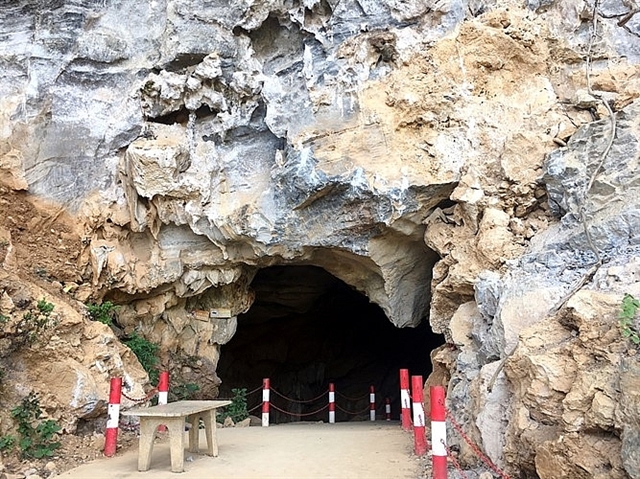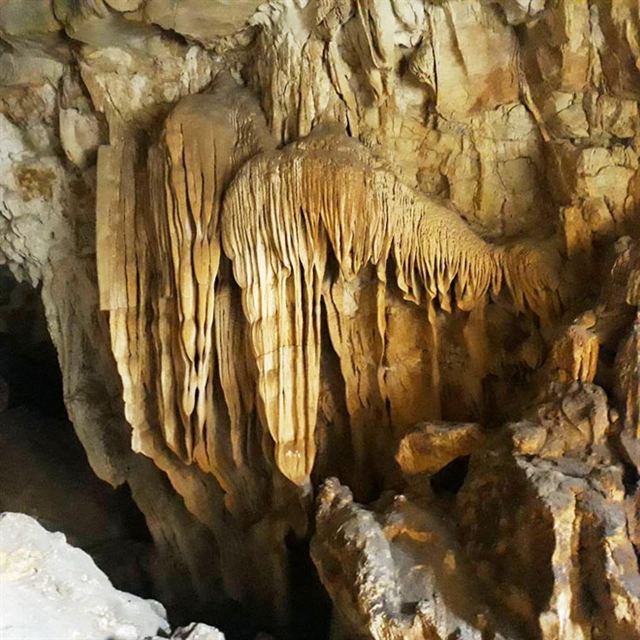A visit to northwestern Điên Biên Province is incomplete without seeing the unique pristine beauty of Khó Chua La Cave, in Pàng Dề A1 Village, Tủa Chùa District. It was a site we would be able to travel to shortly if pandemic restrictions were not in place.

Khó Chua La Cave in Pàng Dề A1 Village, Xá Nhè Commune, Tủa Chùa District. — Photo truyenhinhdulich.vn
The cave, which was formed millions of years ago, was discovered by local people in 2008. It is located about 1,000m above sea level, with a depth of over 800m, divided into three compartments. The mouth of the cave is small and deep, facing the southeast.
Khó Chua La Cave is more than 1km from the headquarters of Xá Nhè Commune People's Committee, about 15km from the centre of Tủa Chùa District. With its wild beauty and many splendid stalactites and strange shapes, the cave is a rare natural beauty compared to other caves in the district.
The cave is named in the Mông language. Khó means cave, Chua means rocky mountain or rock, La means monkey. Thus, Khó Chua La means rocky monkey cave.

Khó Chua La Cave is located about 1,000m above sea level. — Photo thuonghieusanpham.vn
From the parking area, we climbed 180 steps to reach the cave entrance and began our journey to discover the cave’s fairytale beauty.
The entrancing cave is divided into three compartments, each of which has its own mysterious beauty. The ceiling is dome shaped, with stalactites hanging down in sparkling with lines that are sometimes soft and flexible like waterfalls, and sometimes as sharp as sea coral. In the cave, there are still signs that ancient Vietnamese people used to live here, with patterns carved on rock and stalactites over thousands of years old.
The first compartment has a depth of more than 200m, the widest place is 11-15m and the arch is 12-25m high. The cave floor is about 3m lower than the cave entrance, gently sloping and gradually flattening inwards.
The two sides of the cave wall are strips of stalactites falling in yellow, silver, and blue-gray colours that look like a curtain of wind, clusters of rice, chandeliers of different shapes, or even animals. Some stalactites glow brightly when illuminated by the light, creating a magical and mysterious scene.
The more we went into the cave, the more surprised we were by the enchanting beauty of the stalactites. The ceiling of the cave has stalactites shaped like animals such as elephants, deer, dragons, phoenixes, turtles, and birds hiding in vegetation. The temperature in the cave is always at 20 to 21 degrees Celsius, and you can feel the coolness of the air on your skin.

Khó Chua La Cave has many splendid stalactites and strange shapes. — Photo 24h.com.vn
The second compartment is located at a higher position than the first, with a depth of 250m. Its widest place is 13-15m and the arch is 18-25m high on average. The cave floor is mainly concave and rocky. The two sides of the cave have many stalactites interlaced with each other in the shape of cacti and banyan trees, with long roots hanging down or crashing into the cave floor.
In the middle of the second compartment, there were white stalactites that made us feel like we were lost in a thousand-year-old primeval forest. There are large stone pillars that are separated into beautiful stalactites. When we knocked tapped the walls, strange echoing sounds appeared.
Near the end of the second compartment, the cave floor has many curved stone strips shaped like terraces and lotus flowers of different sizes. The shape of the cave becomes even stranger, with the wall and the floor made up of small pebbles. Brown and yellow stalactites form banks, winding and connecting to each other like a small stream.
Near the third compartment under the cave floor, there are many long, sharp stalactite pillars that look like an elaborately decorated castle, with countless rays of white and yellow stones growing from the walls and floor.
The third compartment is lower than the previous two, with a depth of nearly 400m into the mountain. On the ceiling and sides of the cave are yellow and white stalactites hanging down like waterfalls and rice clusters. At the end of this section, there is a cool water flowing from the cave wall, creating mystery and curiosity.
The cave was recognised as a national scenic relic in 2015. It is the honour and pride of local people here.
Located opposite Khó Chua La Cave is Xá Nhè Cave. Both have been ranked as national scenic relics by the Ministry of Culture, Sports and Tourism.
Exploring Khó Chua La Cave, the cultural identity of Tủa Chùa District, is a wonderful journey and truly unforgettable experience.
Giang Thanh
















